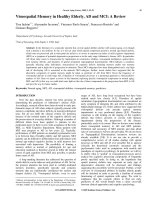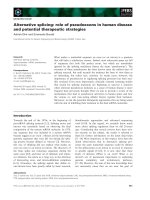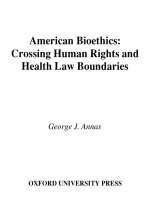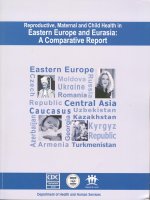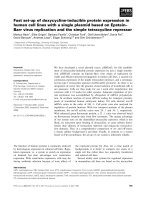Goat milk in human nutrition and health – A Review
Bạn đang xem bản rút gọn của tài liệu. Xem và tải ngay bản đầy đủ của tài liệu tại đây (349.54 KB, 12 trang )
Int.J.Curr.Microbiol.App.Sci (2017) 6(5): 1781-1792
International Journal of Current Microbiology and Applied Sciences
ISSN: 2319-7706 Volume 6 Number 5 (2017) pp. 1781-1792
Journal homepage:
Review Article
/>
Goat Milk in Human Nutrition and Health – A Review
Sachin S. Lad1*, K.D. Aparnathi1, Bhavbhuti Mehta1 and Suresh Velpula2
1
Dairy Chemistry Department, 2Dairy Engineering Department, SMC College of Dairy Science,
AAU, Anand, India
*Corresponding author
ABSTRACT
Keywords
Goat milk,
Human nutrition
and health
Article Info
Accepted:
17 April 2017
Available Online:
10 May 2017
Goats are earliest domesticated animals. Number of the individuals are
maintained them either as a source of the income or as a hobby. Mostly
goats are maintained as a source of the milk and were milked even before
cows. Goat is also called as “Cow of poor man”. Many scientists focused
on the functional properties of the goat milk along with sheep milk. It is
concluded that, these milks have not only high nutritional value but also
therapeutic value and dietary characteristics.
Introduction
Composition of goat milk
In many countries, goat farming is the
important part from the economy point of the
view; especially in the Mediterranean and
Middle East region. Goat farming is well
organized in France, Italy, Spain and Greece
(Park and Haenlein, 2006). Industrialization
of the goat milk is not well successed because
of its poor and insufficient volume. From
1990, interest in the goat milk production is
increased i.e. 10 million MT (1990) to 15.2
million MT (2008). Though there is increase
in the production of the goat milk, still there
is lack of marketing of this milk (Mahmoud,
2010). Goat milk is one of a neutraceutical
health drink. As goat milk is rich in mineral
and vitamin content and has creamy texture, it
is used as the replacer for number of the
supplements which are people consume daily.
Goat milk is quite better as compared to that
of cow milk because of its easy digestibility.
Different milks have different composition.
Composition of the cow, goat and human
milks are mentioned in table 1. Composition
of these milk are vary according to changes in
diet, individuals, season, breed, species,
feeding
managements,
environmental
conditions, stage of the lactation, locality and
condition of the udder.
Goat milk differs from cow and human milk
in having better digestibility, buffer capacity,
alkalinity and therapeutic values.
Fat of goat milk have higher physical
properties i.e. surface tension, viscosity and
specific gravity as compared to cow milk
(Park et al., 2007).
1781
Int.J.Curr.Microbiol.App.Sci (2017) 6(5): 1781-1792
Milk lipid
Milk proteins
Fat is up to 99 % glycerides and steroids. The
fat is present in the milk as “oil-in-water”
type of emulsion. Fat globules of goat‟s milk
observed to be similar to that of cow‟s milk in
lipids composition and properties but goat‟s
milk lacks agglutinin (Jenness, 1980). The
average diameter of globules in goat‟s milk is
about 1.5-2 µm compared to 2.5-3.5 µm for
cow‟s milk and the percentage of globules of
less than 1.5µm is 28% for goat‟s milk verses
10% for cow‟s milk (Le Jaouen, 1981 and
Kalantzopoulos, 1993).
Two distinct phases of milk proteins are an
unstable micellar phase composed of casein
and a soluble composed of whey proteins.
Goat milk contains lesser amounts of the αscasein, higher amounts of the β-casein
fractions and almost equal amounts of the kcasein fractions compared to cow milk. The
major protein in cow milk is αs1casein, while
in goat milk is β casein. Goat milk also
contains equal amount ofαs1-casein, but the
amount and genetic variants differ between
goat populations (Diaz-Castro et al., 2010).
The casein micelles in goat milk differ from
those in cow milk in having greater β-casein
solubilisation, more calcium and phosphorus
and lower heat stability (Horackoval et al.,
2014).
Average size of the fat globules are much
smaller in goat milk i.e. about 65% of the fat
globules are < 3 µm as compared to that of
the cow milk (Park et al., 2007). That‟s why
goat milk is considered as “self
homogenized” milk. In respect to free lipids,
goat milk has higher values than that of cow
milk Cerbulis et al., 1982).
Goat milk has three fatty acids higher (two
fold) as compared to that of cow milk i.e. C8,
C10, and C12 (Juarez and Ramos, 1984).
Medium chain triglycerides (MCTs) are able
to provide energy without being deposited in
the fatty tissue of the body as well as it play a
role in decreasing cholesterol levels in body.
MCTs used for “milky urine” (chyluria) and
chylothorax (lung conditions).
MVTs are also used for treating the food
absorption disorders i.e. diarrhea, steatorrhea
(fat indigestion), cealic disease, liver disease
and digestion problems due to partial surgical
removal of stomach (gasterctomy) or intestine
(short bowel syndrome).
Fatty acids composition of goat milk reported
by various authors and compared with those
of cow milk is summarized in table 2.
Goat milk contains a significantly lower level
of αs-1 casein, a major allergen in bovine
milk (Lara-Villoslada et al., 2004) (Table 3).
Milk carbohydrate
Lactose is the major carbohydrate in goat
milk and the content is slightly lower than in
cow milk. It is synthesized from glucose and
galactose in the mammary gland, where the
milk protein α-lactalbumin plays an important
role (Kunz et al., 2000). Lactose is a valuable
nutrient, because it favors intestinal
absorption of calcium, magnesium and
phosphorous and the utilization of vitamin D.
It also is of major importance during milk
synthesis and during secretion of milk into the
duct system of the udder.
Other carbohydrates found in goat milk are
oligosaccharides,
glycopeptides,
glycoproteins and nucleotides in small
amounts. Goat milk is significantly rich in
lactose-derived oligosaccharides compared to
cow milk. Milk oligosaccharides are thought
to be beneficial to human nutrition because of
1782
Int.J.Curr.Microbiol.App.Sci (2017) 6(5): 1781-1792
their prebiotic and anti-infective properties
(LaraVilloslada et al., 2006). In animal
models, goat milk oligosaccharides have been
shown to have anti-inflammatory effects in
induced colitis (Daddaoua et al., 2006). These
results could be useful in the management of
inflammatory bowel disease (Robinson,
2001).
Goat milk contains a lower concentration of
oligosaccharides in comparison to human
milk, it is greater than in bovine and ovine
(Sheep) milks and the oligosaccharide
structures identified in goat milk are most
similar to that of human milk. This is
particularly significant for infant nutrition as
human milk oligosaccharides are greatly
beneficial for the infant due to their prebiotic
and anti-infective properties.
Milk vitamins
Goat milk has a higher vitamin A content than
cow milk because goats convert all β-carotene
from foods into vitamin A in the milk
(Conesa et al., 2008). For the same reason,
goat milk is always whiter than cow milk.
Both goat and cow milk have low
concentrations of vitamin B6 and vitamin D,
which are both important during infancy
(Juarez et al., 2011) (Table 5).
Goat milk contains a similar amount of
vitamin A as human milk. Vitamin A is
important for both innate and adaptive
immune responses, including cell-mediated
immunity and antibody responses. Vitamin C
is a well-known water-soluble antioxidant that
is found in greater amounts in goat milk than
in cow milk. This vitamin has been shown to
affect many aspects of the immune system
including the regulation of immunity via
antiviral and anti-oxidant properties (Geissler
and Powers, 2011). Goat milk is also a good
source of vitamins such as D, E, thiamine,
riboflavin and niacin. Goat‟s milk has low
levels of foliate (Park, 2006).
Milk mineral
It is noteworthy that milk of each species has
a particular individual pattern of minerals,
which may be a pointer of the relative
nutritional importance of the element.Goat
milk is reported to have higher content of
Potassium, Calcium, chloride, Phosphorus,
Selenium, Zinc and Copper than cow milk
(Krstanovic et al., 2010; Lopez-Aliaga et al.,
2005).Cow milk is distinguished by a lower
concentration of sodium, phosphorus, zinc,
copper and manganese with respect to other
milk types (goat and human milk). From the
viewpoint of human nutrition, therefore the
milk of goat is to be preferred to that from
cow (Bunaji) due to higher content of most of
the minerals. Hence goat milk, like cow milk
cannot replace human milk in young children
but could complement it. A greater diffusion
of knowledge on nutritional value of goat
milk could promote its complementary effect
in human diet, mostly if used highest mineral
contents compared to that of cow or human
milk (Belewu and Aiyegbusi, 2002) (Table 6).
Dietary and medical significance of goat
milk
Goat milk is considered as an ideal food for
all the ages as it contains essential vitamin
and minerals. It is one of the key healthy
drink (www.draxe.com).
Functional food
Milk calcium and proteins along with the
newly formed structures created by reaction
of these are of great concern from the
technological point of view. Milk and
colostrum are rich in bioactive components
which are important to regulate weight and
hypertension. It also influences digestion and
health properties. As goat milk is rich in such
components, we can call it as a „functional
and neutraceutical‟ drink.
1783
Int.J.Curr.Microbiol.App.Sci (2017) 6(5): 1781-1792
Easily digestible fats and proteins
The size of the fat globules of the goat milk is
smaller than cow milk, therefore it makes it
easy to digest. The composition of the protein
of the goat milk allows forming a softer curd
which assists to digestive health and comfort.
Caprine casein micelles contains more
inorganic phosphorous and calcium, are less
heat stable, are less solvated and lose β-casein
more quickly than bovine casein micelle.
Goat milk contains less α s casein and often
has more αs2 than αs1-casein (MoraGutierrez et al., 1991). β-casein and K-casein
are more in the goat milk than cow milk,
therefore weak gel is obtain which is
beneficial for the better digestibility but it is
responsible for reduced cheese yield.
Lower in lactose
Goat milk contains slightly lower lactose
content than cow milk. Lactose intolerance is
cause because of the deficiency of Lactase
which digests milk sugar, Lactose. In patients
suffering
from
lactose
intolerance,
unhydrolyzed lactose passes to large intestine.
In large intestine, this unhydrolyzed lactose is
fermented by microbes leading to gas
formation and release of the free fatty acids
which causes gastrointestinal disturbances
such as diarrhea, abdominal pain and
flatulence (Russell et al., 2011). Anecdotal
evidences show that goat milk is easy to
digest because of softer curd formation.
Casein profile of goat milk allows lactose to
pass through large intestine more fastly and
prevents the symptoms of lactose intolerance
(Robinson, 2011). However, goat milk is not
recommended for the patients suffering from
lactose
tolerance
(www.globalhealingcenter.com/naturalhealth/goat-milk-benefits). Along with its
digestibility it explains that why lactose
intolerance patients can enjoy goat milk
without any repercussions.
Haeilein et al., (2004) indicated that treatment
with goat milk typically cure 30-40 %
problem cases of childhood cow milk allergy,
which can be higher in some cases (One study
shows improvements in 49 out of 55 children
treated with goat milk).
Less allergic proteins
An allergy is defined as an altered or
abnormal tissue reaction following exposure
to foreign antigen (McCullough, 2003). It is
well known that proteins are essentials for the
body functioning like growth, development
and repair of the body. They are the most
common antigens. Infants are most commonly
sensitive to proteins, about 2-6 % incidence
(Lara-Villoslada et al., 2004). Some
researches show that, cow milk intolerance is
often
due
to
alpha
s-1
casein
(www.mtcapra.com/benefits-of-goat-milk-vscow-milk/). It is interesting that, the level of
the alpha s-1 casein goat milk is 89 % lower
than that of cow milk. Hence, it is less
allergic, goat milk shown improvements in
colic, minor digestive disorders, asthma and
eczema over cow milk and people with cow
milk sensitivities (McCullough, 2003).
Allergenicity of goat milk and cow milk in
mice was studied and it is demonstrates that
the goat milk is beneficial immunologically
on reducing specific markers involved in the
allergic response (Lara-Villoslada et al.,
2004). Compared to goat milk, cow milk
significantly
increased
markers
of
inflammation including cytokine interleukin-4
(IL-4) and antigen-specific immunoglobulin
G1 (IgG1), key markers in hypersensitivity
reactions. IgG1 binds to mast cells and
promotes degranulation (the initiation of an
allergic response), causing an increase in
histamine levels and the resulting allergic
symptoms. This reaction to cow milk was in
contrast to goat milk, which did not induce an
allergic response. Figure 1(A and B)
1784
Int.J.Curr.Microbiol.App.Sci (2017) 6(5): 1781-1792
demonstrates the differences in IgG1 (A) and
histamine (B) production in response to cow
milk versus goat milk administration.
Goat milk proves its anti-allergy benefits
upon drinking when a similar trial in children
with cow milk protein allergies was taken.
Drinking of cow milk had significantly higher
levels of the inflammatory marker tumour
necrosis factor-α (TNF-α) than those who
consumed goat milk. TNF-α is a primary
mediator of adverse reactions to cow milk
protein including gastrointestinal distress,
respiratory and cutaneous symptoms such as
eczema. In addition to the lack of
inflammatory effects with goat milk
consumption, subjects who drank goat milk
also had higher levels of the antiinflammatory cytokine IL-10. IL-10 which
suppresses the formation of pro-inflammatory
cytokines such as TNF-α and is thought to
contribute to immune suppression and thus
prevent reactions to antigens in cow milk
(Albenzio et al., 2012), table 7 shows the
effect of cow milk compared to goat milk on
these allergenic markers.
Anti-inflammatory
properties
and
anti-mucousal
Cow milk may responsible for the allergens
because of its protein fractions, while goat
milk is not. On other hand, along with these,
cow milk contains high content of fat than
goat milk which may increase mucous buildup. Goat milk not causes irritation in the gut,
because the size of the fat globules of the goat
milk is one ninth the size of cow milk fat
globules.
Goat milk plays a key role in almost all
biological reactions and exerts antioxidant
and anti-inflammatory effects in the body.
This is important as inflammation is the
body's primary response to infection and
oxidation has been linked to the development
of many diseases, including cancer.
Furthermore, other factors such as the
maintenance of a healthy intestinal micro
flora with the help of probiotics and prebiotics
(Also contained in goat milk) are essential for
protecting against the negative effects of
pathogenic infection allergy (Shea et al.,
2004).
Heart health
Low-density lipoprotein (LDL) is such
atherogenic lipoprotein which transports
cholesterol from the liver to the blood vessels
and is often called "The bad cholesterol". The
"good" cholesterol is the high-density
lipoprotein
(HDL)
which
transports
cholesterol from the vessels to the oxidative
modification of LDL (ox-LDL) plays a
pivotal role in atherosclerosis progression.
This implies that antioxidants, which could
inhibit LDL oxidation, should be effective in
suppressing atherosclerosis (Lindqvist, 2008).
Proteins of the goat milk are important source
of the angiotensin converting enzyme (ACE),
antihypertensive peptide and inhibitory
peptides. They are able to control microbial
infection and also provide disease defense.
Minor
milk
proteins
include
immunoglobulins, lactoferrin, transferrin,
proteose peptone, ferritin, calmodulin
(calcium binding protein), prolactin and folate
binding protein. Non-protein nitrogen (NPN)
of human and goat milk is higher than that of
the cow milk. Taurine in the goat milk which
is derived from the sulphur-containing amino
acid has important metabolic functions as
does carnitine – important nutrient for
neonate. As is evident from table 2, the
mineral and vitamin content of goat milk are
mostly higher than that of cow milk (Park et
al., 2007) (Table 4).
Goat milk is better than cow milk in
monounsaturated fatty acids (MUFA),
1785
Int.J.Curr.Microbiol.App.Sci (2017) 6(5): 1781-1792
polyunsaturated fatty acids (PUFA) and
medium chain triglycerides (MCT). These are
beneficial for the cardiovascular conditions.
Along with these, goat milk has lower level of
the cholesterol than cow milk (Haenlein,
2004). Because of the balanced fatty acid
profile of the goat milk, it helps to prevent
atherosclerosis, heart attacks, strokes and
other heart complications. High potassium
content of the goat milk reduces the blood
pressure.
Goat milk exerts hypocholesterolemic effect.
Goat milk consumption reduces plasma
triglyceride and hence had positive effect on
lipid metabolism (Lopez-Aliaga et al., 2005).
Goat milk is reported to reduce the total
cholesterol level and maintain adequate
triglycerides and transaminases (glutamate
oxaloacetate transaminase (GOT) and
glutamate pyruvate transaminase (GPT) –
indicators for liver intoxication). This makes
goat milk to control and prevent coronary
heart
diseases
(CHDs).
(www.globalhealingcenter.com/naturalhealth/goat-milk-benefits).
Immunity booster
Selenium is one of the key component for the
immune system functionality. Small amount
of the selenium are found in the cow milk, but
significant amount of the same found in goat
milk. Hence, goat milk and its products are
acts as immunity booster and able to protect
an individual from illness.
Many types of cells are involved in the innate
and adaptive immune response, with Tlymphocytes (T-cells), Natural Killer (NK)
cells and B-lymphocytes (B-cells) as the main
players. Although immunoglobulin's (Ig) are
similar in structure, minor differences within
the main immunological classes (IgG, IgM,
IgA, IgD and IgE) are associated with a
variety of biological properties and IgG and
IgA account for the majority of serum
immunoglobulins. A number of factors
influence our immune health and nutrition in
particular is main determinant of the body's
immune response.
Even if goat milk might not be a perfect
alternative for people with cow milk allergy,
very
recent
studies
have
showed
immunomodulatory effects from goat milk
both in in-vitro and human studies. Recently
investigated the effects of goat milk on human
blood cells in terms of nitric oxide (NO) and
cytokine release, the results demonstrated that
goat milk was able to activate NO release
from blood cells as well as triggering of
cytokine production (IL-10, TNF-a and IL-6).
The NO release could have cardio-protective
effects in the milk consumer and also expose
antibacterial activity and thereby prevent
infections.
Better nutrient uptake efficiency
As the chemical composition of the goat milk
is much closer to that of the human milk, it
easily assimilates in the body. Therefore it
enhances the bioavailability of the nutrients
present into it. Authors reported that, goat
milk consumption increases the uptake of Iron
and Copper in digestive tract (Gajewska et al.,
1997).
Prebiotic supplement
Goat milk has higher level of the
oligosaccharides as human milk than cow
milk. It is well known that, these acts as
prebiotics in gut and improve the health of the
digestive tract (Raynal-Ljutovac et al., 2008).
They are responsible for the beneficial
bacteria i.e. Bifidobacteria in the intestine.
Bifidobacteria exert a wide range of health
benefits
including
immune-stimulation,
prevention of pathogenic infections, anticarcinogenic activity and cholesterol lowering
activity in addition to improving lactose
maldigestion (Russell et al., 2011).
1786
Int.J.Curr.Microbiol.App.Sci (2017) 6(5): 1781-1792
Ultra-nourishing
In naturopathic medicine, goats are referred as
bioorganic sodium animals whereas, cow are
calcium animals. Bioorganic sodium is an
important key element in maintaining joints
mobile and limber. Goat milk provides 35 %
of our daily needs of calcium in a cup. Along
with these, just a cup of goat milk provides up
to 20 % of daily needs of riboflavin. Along
with phosphorous, goat milk contains high
level of the potassium and Vitamin B12.
Goat milk improves Zn bioavailability, a
mineral with antioxidant capacity (Zago and
Oteiza, 2001). The better nutritive utilization
of goat milk fat (Alferez et al., 2001) provides
a lower substrate for lipid peroxidation and
consequently decreases the generation of free
radicals in this type of milk, explaining once
more the lower TBARS levels found in the
groups animals consuming the goat milk. The
positive role on genomic stability of the
habitual consumption of goat milk, even
during Fe-overloading feeding regime, fact
that could be due, at least in part to the high
bioavailability of Mg and Zn (Diaz-Castro et
al., 2009), together with its better fat quality
(Alferez et al., 2001). Magnesium metabolism
enhances genomic stability because of the
following: DNA is continuously damaged by
environmental mutagens and by endogenous
processes. To keep mutation frequencies low,
cells have evolved different types of DNA
repair systems. Nucleotide excision repair is
mainly involved in the removal of DNA
damage induced by environmental mutagens
and Mg is an essential cofactor in virtually all
steps of nucleotide excision repair. Secondly,
endogenous DNA damage is mainly repaired
by base excision repair (BER) (Hartwig,
2001).
Anti-carcinogenic
Goat milk has a high content of conjugated
linoleicacid (CLA) (Jirillo et al., 2010). Anticarcinogenic properties of CLA have been
reported against mammary and colon cancer
(Liewet al., 1995) in animal models, as well
as in vitro models of human melanoma
(Shultz et al., 1992) colorectal and breast
cancer (Durgam and Fernandes, 2000). The
mechanism by which CLA inhibit tumor
development is not fully understood, although
perturbation of the eicosanoid-dependent cell
signaling systems, anti-oxidative effects and
disturbance of the receptor mediated actions
of estrogen have all been suggested by
fermented goat milk (Jirillo et al., 2010).
Table.1 Chemical composition and caloric value of ruminants and human milk
Components
Total solids
Fat
Total protein
Casein
Whey protein
Lactose
Minerals
Energy (kcal/100g)
Cow
12.3
3.4
3.2
2.5
0.65
4.6
0.7
66
Goat
13.2
4.0
3.6
2.9
0.61
4.5
0.8
70
Source: (Alichanidis and Polychroniadou 1996)
1787
Human
12.4
3.8
1.2
0.4
0.70
7.0
0.2
63
Int.J.Curr.Microbiol.App.Sci (2017) 6(5): 1781-1792
Table.2 Fatty acids composition percent of goat‟s milk reported by
different authors and compared with those of cow‟s milk
Acid
Goat milk
Garcia
et Boccignone
al., 1979
et al., 1981
C 4.0
C6.0
C8.0
C10.0
C12.0
C14.0
C14.1
C16.0
C16.1
C18.0
C18.1
C18.2
C18.3
2.3
2.7
3.2
11.5
5.3
10.4
24.9
9.7
21.6
1.6
1.2
1.81
2.03
2.68
8.45
5.21
10.52
0.96
24.33
2.58
9.49
23.96
1.68
-
Sawaya et Martin
al., 1994
Hernandez
et al., 1986
3.0
1.8-2.8
2.0
2.2-3.4
2.0
2.4-3.9
6.1
8.8-13.4
2.9
3.8-5.5
9.5
8.5-11.6
0.4
0.5-0.8
28.6
23.3-32.1
2.5
1-2
10.3
4.3-11.2
26.3
16.2-26.6
2.6
1.2-2.5
0
Cow milk
Hellin et al., Martinez1998
Castro
et
al., 1979
3
2.5-6.2
6.3
1.5-3.8
2.9
1.0-1.9
10.4
2.1-4.0
5.6
2.3-4.7
12.38
8.5-12.8
0.6-1.5
34.8
24.0-33.3
1.3-2.8
6.8
6.2-13.6
13.3
19.7-31.2
3.9
1.36-5.2
0.9
-
Table.3 Comparison of protein content in goat milk and cow milk
Protein
Goat milk
Cow milk
R.S.D.a
Level of
significance
Casein (Cn)
αs1-Cn
αs2-Cn
β+k-Cn
Whey
proteins
82.70
18.92
8.52
55.26
17.30
82.65
30.80
7.50
44.35
17.35
0.76
1.71
1.83
2.79
0.76
NSc
-NS
-NS
Difference
(%) for goat
milkb
- 62.8
+19.7
a
R.S.D = residual standard deviation.Source: (Ceballos et al. 2009)
Difference (%) for goat milk = [(goat milk value – cow milk value)/ goat milk value] *100
c
NS = P> 0.05; --P<0.001
b
Table.4 Comparison of amino acids content in goat milk and cow milk
Particulars
Arginine
Histidine
Isoleucine
Leucine
Lysine
Methionine
Phenylalanine
Threonine
Tryptophan
Valine
Goat
277
387
370
330
426
381
337
354
259
381
Source: (Haenlein, 2001)
1788
Cow
277
387
355
339
384
395
346
324
270
349
Int.J.Curr.Microbiol.App.Sci (2017) 6(5): 1781-1792
Table.5 Vitamin content of ruminant and human milk
Vitamins (per 100 g)
Vitamin A (IU)
Vitamin D (IU)
Thiamine (mg)
Riboflavin (mg)
Niacin (mg)
Pentathenic acid (mg)
Vitamin b6 (mg)
Folic acid (µg)
Biotin (µg)
Vitamin B12 (µg)
Vitamin C (µg)
Goat
185
2.3
0.068
0.21
0.27
0.31
0.046
1.0
1.5
0.065
1.29
Milk
Cow
126
2.0
0.045
0.16
0.08
0.32
0.042
5.0
2.0
0.357
0.94
Human
190
1.4
0.017
0.02
0.17
0.20
0.011
5.5
0.4
0.03
5.00
Source: (Park et al., 2007)
Table.6 Mineral content of ruminant and human milk
Constituents
Type of Milk
Goat
Cow
Minerals (mg/100 g)
Ca
134
122
P
121
119
Mg
16
12
K
181
152
Na
41
58
Cl
150
100
S
28
32
Fe
0.07
0.08
Cu
0.05
0.06
Mn
0.032
0.02
Zn
0.56
0.53
Source: (Park et al., 2007)
Human
33
43
4
55
15
60
14
0.20
0.06
0.07
0.38
Table.7 Cytokine levels (pg/ml) in lymphocytes of children stimulated against protein fractions
of cow and goat milk
Cytokine levels (pg/ml) in cultured supernatants of lymphocytes of children against protein
fractions of cow and goat milk
Species
Milk protein fraction
SEM
Effects, P
Protein
Casein
β-lg
Species
mixturea
TNF-α
Cow
833.67A
1362.38bA 2401.81bB 220
*
Goat
651.02
380.37a
366.45a
IL-10
Cow
236.82aA
482.17B
242.49A
70
*
Goat
460.94bB
448.81AB
441.94AB
IL-12
Cow
164.66
106.64
210.21
52
NS
Goat
130.61
74.05
173.3
Mean followed by different letters differ for P<0.05: a and b for species effect; A and B for milk fraction
effect. NS, not satisfactory
a
protein mixture-casein; whey protein (80:20 w/w),; * P<0.05.Source: (Albenzio et al. 2012)
1789
Int.J.Curr.Microbiol.App.Sci (2017) 6(5): 1781-1792
Fig.1A and B Serum levels of IgG1 and Histamine following
Cow Milk (CM) and Goat Milk (GM)
Conversion of milk into products
Goat milk is produced at small farms
traditionally. Goat milk and its products were
manufactured and consumed since long
period of the time. Fresh milk obtained under
sanitary conditions from properly fed and
managed healthy goats is free from
objectionable odour and flavor (Roy and
Vadodaria, 2006). Well known products from
the goat milk are Roquefort cheese and
Leben. On other hand, goat milk is not
suitable for the preparation of Ghee. The
reason behind it is relatively small sized fat
globules which cause problems during the fat
separation and its associated odour and flavor.
Goat milk is a good source for the preparation
of the Infant formulae.
Recently, utilization of the goat milk for
product manufacturing increases because of
its known functional properties and health
benefits, along with Cheese and Yoghurt,
different products are manufactured from goat
milk such as UHT, evaporated milk,
pasteurized beverages, ice-cream, milk
powder and traditional goat milk products
(Pandya and Ghodke, 2007).
On other side, goat milk cause “goaty” and
“mutton” flavor. Along with these, if goat
milk products are to be used in replacement
diets, it is necessary to incorporate folic acid
supplements, as goat milk is poor in the folic
acid (Pandya and Khan, 2006).
1790
Int.J.Curr.Microbiol.App.Sci (2017) 6(5): 1781-1792
In conclusion, researchers suggest that, “goat
milk can be considered to be a neutraceutical
health drink”. Goat milk is the good source
for those who are suffer from the cow milk
protein allergy or intolerance to cow milk.
Along with these, who are suffering from
anemia, osteoporosis and malabsorption, they
should go for goat milk. Now days, because
of the functional and neutraceutical properties
of goat milk, goat milk gained major attention
and increased its demand. Goat milk is better
for the infants and growing children, bur
caution should be exercised that this milk
should be supplemented with nutrient like
folic acid, which is deficient in it.
References
Albenzio, M., Campanozzi, A., D'Apolito, M.,
Santillo, A., Petioello Mantovani, M. 2012.
Differences in protein fraction from goat
and cow milk and their role on cytokine
production in children with cow's milk
protein allergy. Small Ruminant Res., 105:
202-205.
Alferez, M.J.M., M. Barrionuevo, I. LopezAliaga, M.R. Sanz-Sampelayo and F.
Lisbona, 2001. Digestive utilization of goat
and cow milk fat in malabsorption
syndrome. J. Dairy Res., 68: 451-461.
Belewu, M.A. and Aiyegbusi, O.F. 2002.
Comparison of the Mineral Content and
Apparent Biological Value of Milk from
Human,Cow and Goat. J. Food Technol.,
Africa, 7: 9-11.
Ceballos, L., Morales, E., de la Torre Adarve, G.,
Diaz Castro, J., Martinez, L., Remedios, S.
2009. Composition of goat and cow milk
produced under similar conditions and
analyzed by identical methodology. J. Food
Composition and Analysis, 22: 322-329.
Conesa, C., L. Sanchez, C. Rota, M. Perez, M.
Calvo and S. Farnoud, 2008. Isolation of
lactoferrin from milk of different species;
calorimetric and antimicrobial studies.
Comp Biochem. Physiol., 150: 131-139.
Daddaoua, A., V. Puerta, P. Requena, A. Martinez
Ferez, E. Guadix, F. Sanchezde Medina, A.
Zarzuelo, M.D. Suarez, J. Boza and O.
MartinezAugustin, 2006. Goat milk
oligosaccharidesare anti-inflammatory in
rats with hapten induced colitis. J.
Nutrition, 136: 672-676.
Diaz-Castro, J., M.J.M. Alferez, I. Lopez-Aliaga,
T. Nestares and M.S. Campos, 2009. Effect
of calcium-supplemented goat or cow milk
on zinc status in rats with nutritional
ferropenic anaemia. Int Dairy J., 19: 116121.
Diaz-Castro, J., S. Hijano, M.J.M. Alferez, I.
Lopez-Aliaga and T. Nestares, 2010. Goat
milk consumption protects DNA against
damage
induced
by chronic iron overload in anaemic rats.
Int Dairy, J., 20: 495-499.
Haelein, G.F.W. 2001. The nutritive value of
Sheep Milk. Inter. J. Anim. Sci., 160: 253268.
Haelein, G.F.W. 2004. Goat milk in human
nutrition. Small Rumin. Res., 51: 154-163.
Haenlein, G.F.W. 2004. Goat milk in human
nutrition. Small Ruminant Res., 51: 155163.
Hartwig, A. 2001. Role of magnesium in genomic
stability. Mutat Res., 465: 113-121.
Horackoval, S., P. Sedlackova1, M. Slukovaand
P.
Milada. 2014. Influence of Whey,
Whey Component and Malt on the Growth
and Acids Production of Lactobacilli in
Milk. Czech J. Food Sci., 32: 526-531.
Jenness, R. 1980. Composition and characteristics
of goat milk: Review. J. Dairy Sci., 63:
1605-1630.
Jirillo, F., G.D. Martemucci, A.G. Alessandro,
M.A. Panaro, A. Cianciulli, M. Superbo
and T. Magrone, 2010. Ability of goat milk
to modulate healthy human peripheral
blood lymphomonocyte and polymorpho
nuclear cell function: In vitro effects and
clinical implications. Curr. Pharmaceutical
Design, 16: 870-876.
Juarez, M., M.C. Martin-Hernandez and M.
Ramos. .2011. Biochemical characteristic
of three types of goat cheese. J. Dairy Sci.,
75: 1747-1752.
Krstanovic, V., V. Slacanac, R. Bozanic, J. Hardi,
J. Rezessyne and M. Lucan. 2010.
Nutritional and therapeutic value of
fermented caprine milk. Int. J. Dairy
Technol., 63: 171-189.
1791
Int.J.Curr.Microbiol.App.Sci (2017) 6(5): 1781-1792
Kunz, C., S. Rudloff, W. Baier, N. Klein and S.
Strobel, 2000. Oligosaccharides in human
milk: structural, functional and metabolic
aspects. Annu Rev. Nutr., 20: 699-722.
Lara-Villoslada, F., Olivares, M., Jimenez, J.,
Boza, J., Xaus, J. 2004. Goat milk is less
immunogenic than cow milk in a murine
model of atopy.
J. Pediatric
Gastroenterol., 39: 354-360.
Liew, C., H.A. Schut, S.F. Chin, M.W. Pariza and
R.H. Dashwood. 1995. Protection of
conjugated linoleic acids against 2-mino-3methylimidazo-4,
5-quinoline-induced
colon carcinogenesis in the F344 rat
inhibitory
mechanisms.
Carcinogenesis, 16: 3037-3043.
Lindqvist, H. 2008. Influence of herring
(Clupeaharengus)
intake
on
risk,
Department of chemical and biological
engineering.
Goteborg:
Chalmers
University of Technology.
Lopez-Aliaga, I., M.J. Alferez, M.T. Nestares,
P.B. Ros, M. Barrionuevo and M.S.
Campos, 2005. Goat milk feeding causes an
increase in biliary secretion of cholesterol
and a decrease in plasma cholesterol levels
in rats. J. Dairy Sci., 88: 102-141.
McCullough, F. 2003. Nutritional evaluation of
goat's milk. Health Food J., 105: 239-251.
Park, Y.W. 1994. Hypo-allergenic and therapeutic
value of goat milk. Small Rumin. Res., 14:
151-161.
Park, Y.W. 2006. Goat Milk- Chemistry and
Nutrition. In: Handbook of Milk of NonBovine Mammals. Y.W. Park and G.F.W.
Haenlein, eds. Blackwell Publishers. Ames,
Iowa and Oxford, England. Pp. 34-58.
Park, Y.W., M. Juárez, M. Ramos, and G.F.W.
Haenlein.
2007.
Physico-chemical
characteristics of goat and sheep milk.
Small Ruminant Res., 68: 88-113.
Raynal-Ljutovac, K., Lagriffoul, G., Paccard, P.,
Guillet, I., Chilliard, Y. 2008. Composition
of goat and sheep milk products: An
update. Small Ruminant Res., 9: 57-72.
Robinson, F. 2001. Goats milk – a suitable
hypoallergenic alternative. British Food J.,
108: 192-208.
Roy, S.K. and Vadodaria, V.P. 2006. Goat Milk
and Its Importance. Indian Dairyman, 57:
76-81.
Russell, D., Ross, R., Fitzgerald, G., Stanton, C.
2011. Metabolic activities and probiotic
potential of Bifidobacteria. Int. J. Food
Microbiol., 149: 88-105.
Shea, O., M. Bassaganya, J. Riera and I.C.M.
Mohede.
2004.
Immunomodulatory
properties of conjugated linoleic acid.
American Society for Clin. Nutrition, 79:
1199-1206.
Shultz, T.D., B.P. Chew, W.R. Seaman and L.O.
Luedecke, 1992. Inhibitory effect of
conjugated dienoic derivatives of linoleic
acid and β-carotene on the in-vitro growth
of human cancer cells. Cancer Lett., 63:
125-133.
Zago, M.P. and P.I. Oteiza. 2001. The antioxidant
properties of zinc: interactions with iron
and antioxidants. Free Radic. Biol. Med.,
31: 266-274.
How to cite this article:
Sachin S. Lad, K.D. Aparnathi, Bhavbhuti Mehta and Suresh Velpula. 2017. Goat Milk in
Human Nutrition and Health – A Review. Int.J.Curr.Microbiol.App.Sci. 6(5): 1781-1792.
doi: />
1792
